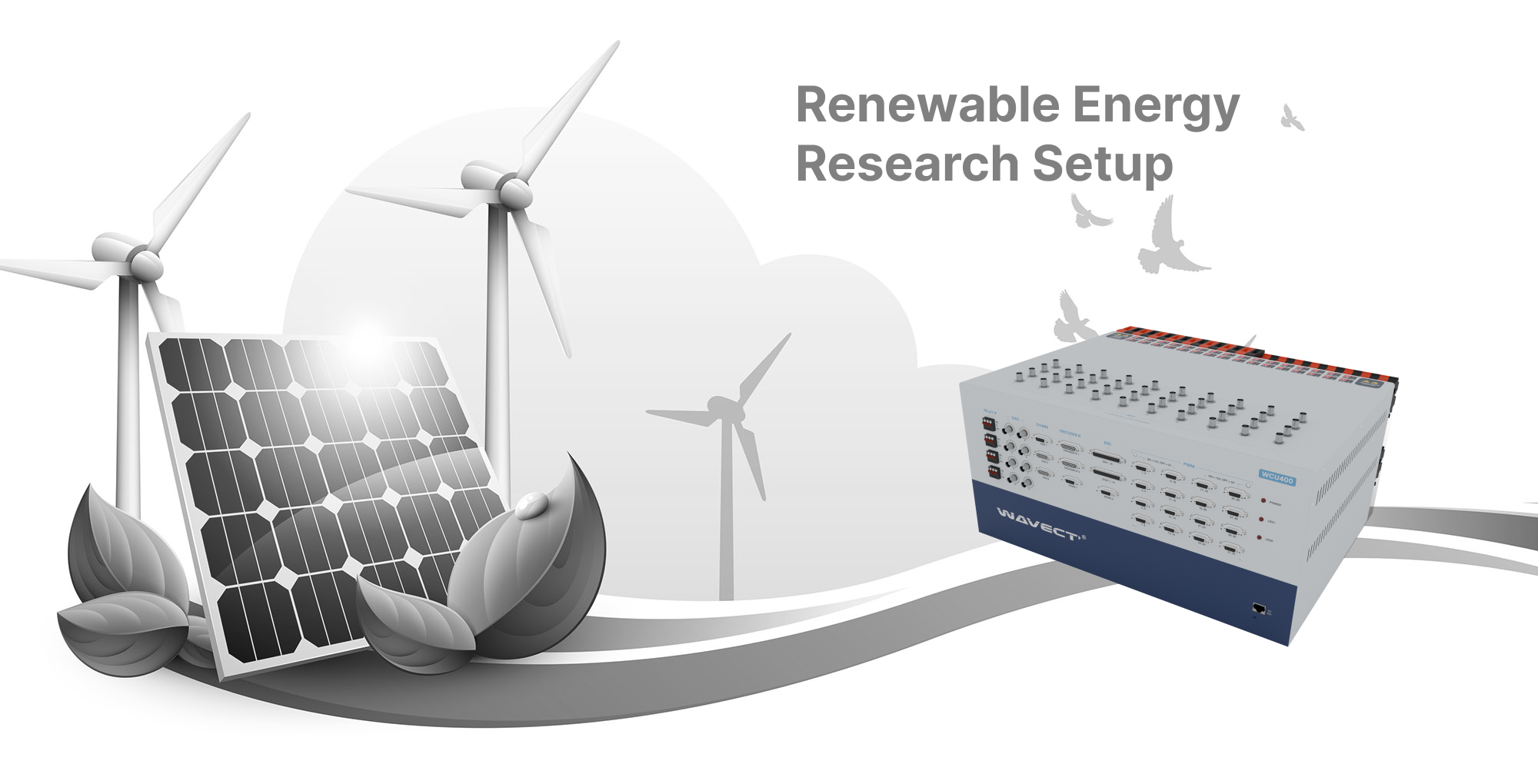
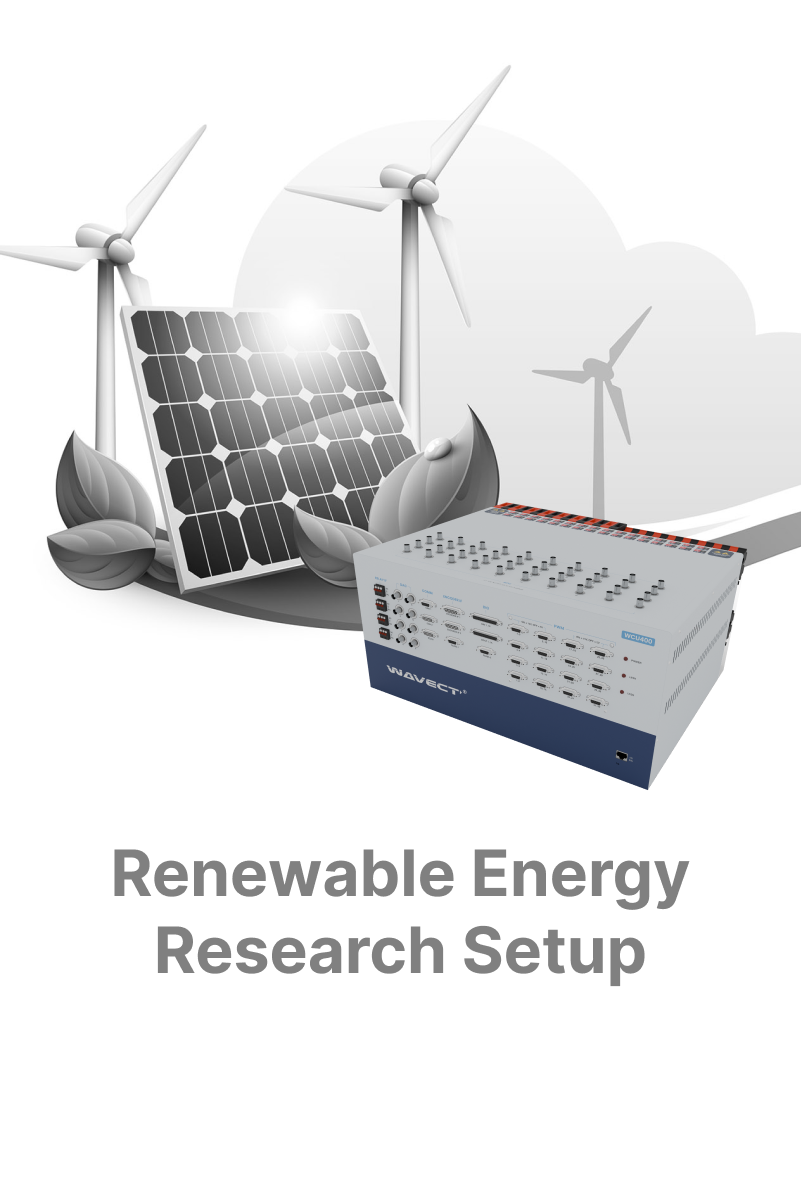
Wind energy conversion system
DFIG and PMSG Based Wind energy conversion systems are capable of independent control of the active and reactive power flowing between the supply and the supply-side converter. DFIG or PMSG is driven by a torque controlled DC drive which emulates the wind turbine. For a specific wind velocity and pitch angle, DC motor will generate the exact torque which will be generated by the wind turbine in those conditions.
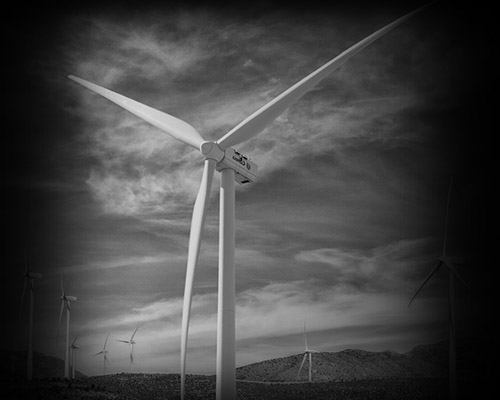
Solar PV Energy Generation Research system
This system is the most common and easy to deploy research setup. The Proposed Configuration is quite open scalable and modular, therefore there are multi-dimensional provisions to deploy the entire configuration or the individual components.
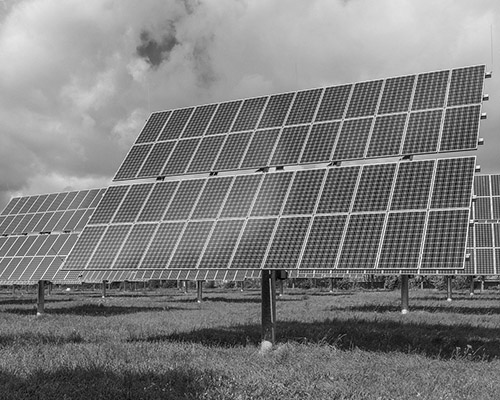
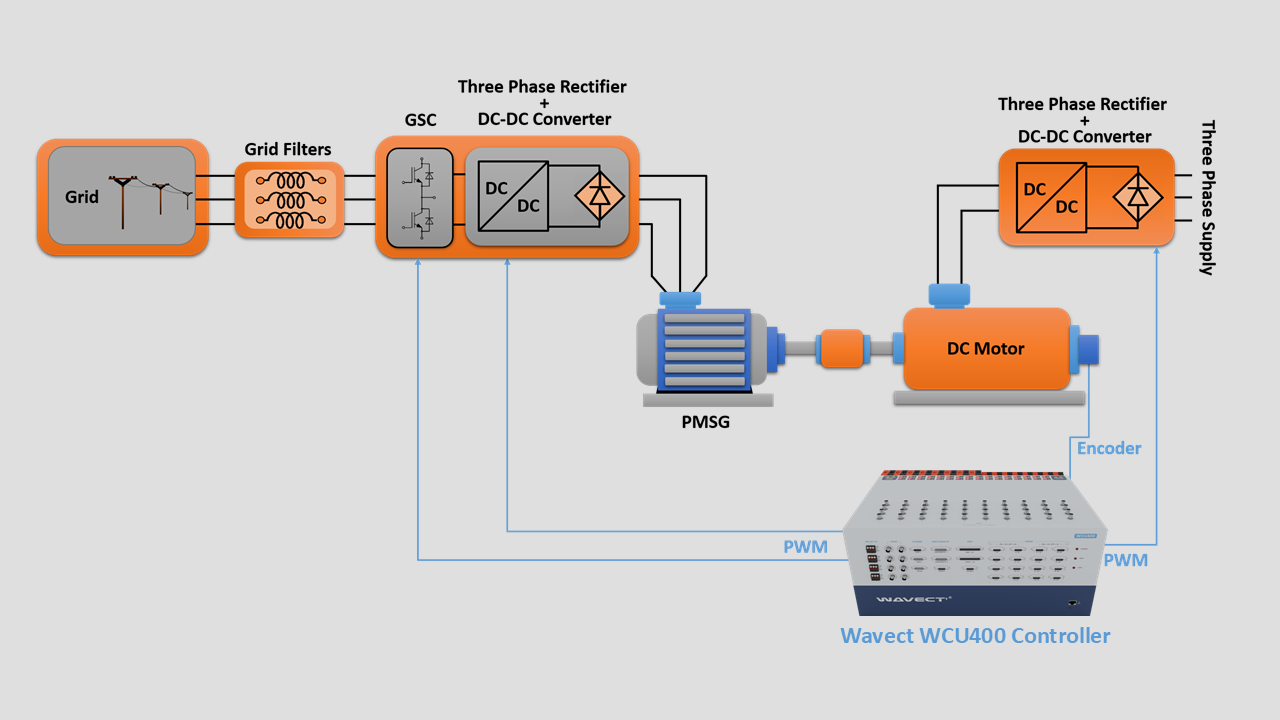
PMSG Based Wind energy conversion system
This setup is mostly prefered to use along with Microgrid setup. A separately excited DC Motor is coupled with a Permanent Magnet Synchronous Generator. The controller gets wind-velocity data from a wind characteristics and calculates the instantaneous turbine torque from a given turbine-blade characteristic.
Send EnquirySpecifications
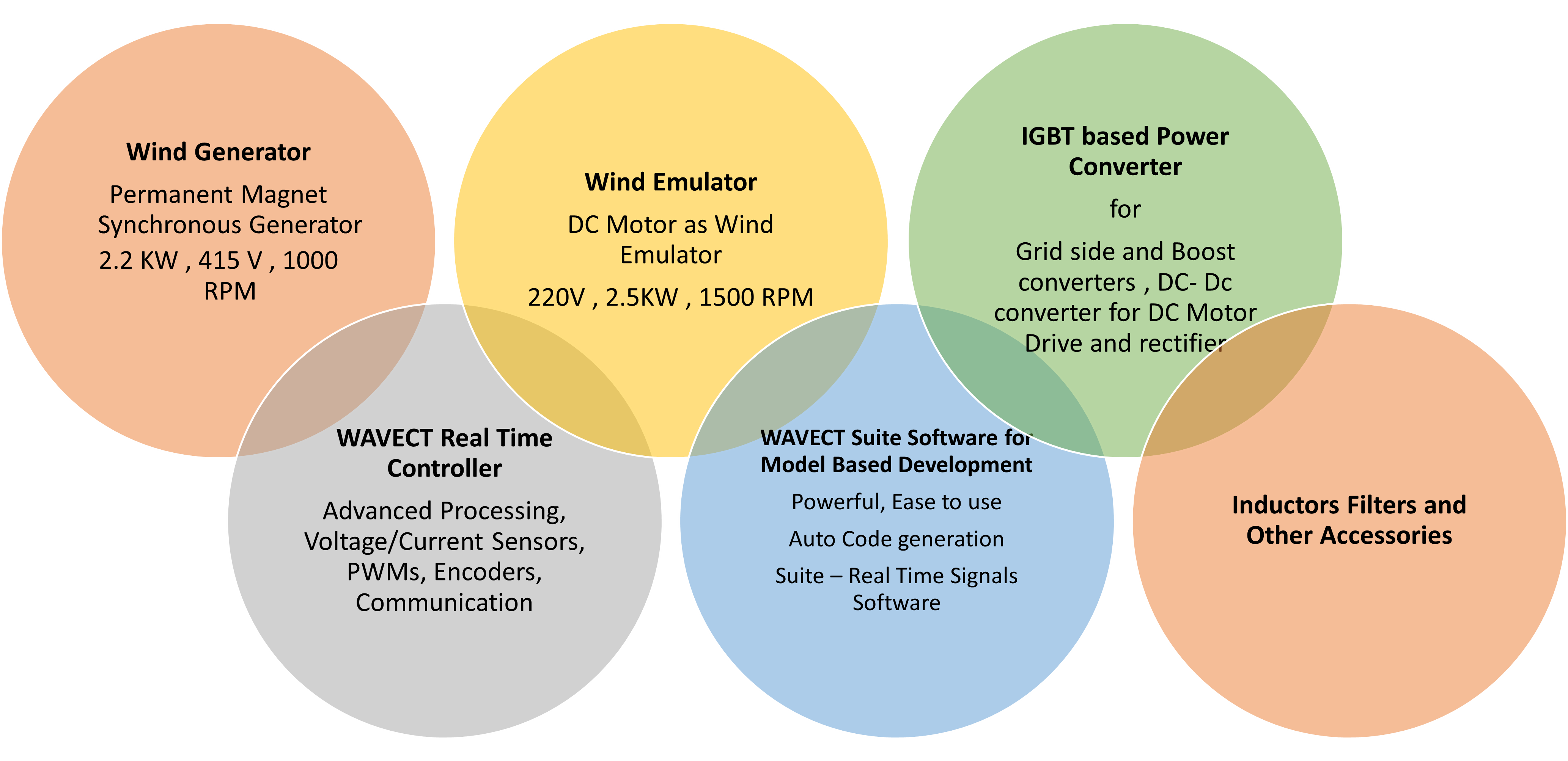
Key Functionalities
PMSG Wind Energy setup is fully user programmable. To quick start the user control design process, system is delivered with a full fleshed reference design. This reference design shows the complete operation of the setup. Its control design key functions are as follows.
- Wind Turbine Emulation
- Dynamic Parameters: wind velocity and pitch angle beta
- MPPT Algorithm for Wind
- Independent Active Power(P) & Reactive Power (Q) control for Grid Side Converter(GSC))
- Auto-isolation of emulator, generator and converters under faulty conditions.
DFIG Based Wind energy conversion system
DFIG is driven by a torque controlled DC drive which emulates the wind turbine. For a specific wind velocity and pitch angle, DC motor will generate the exact torque which will be generated by the wind turbine in those conditions.
Send Enquiry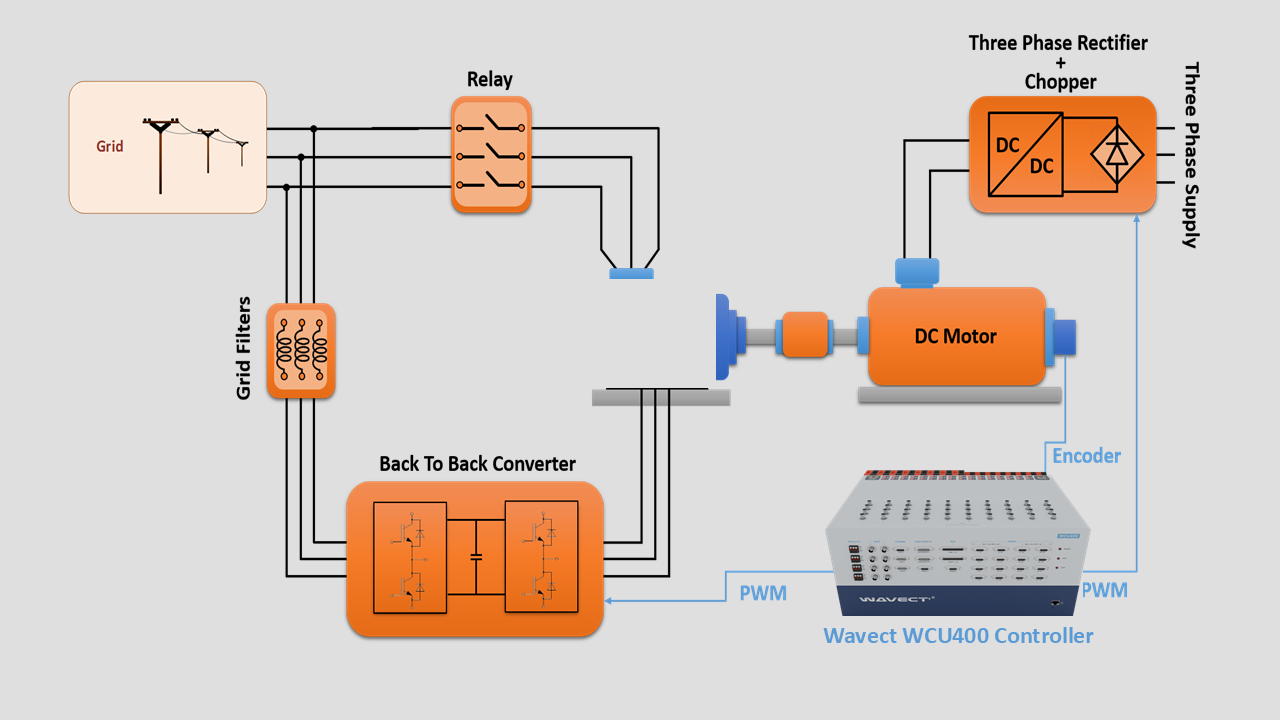
Specifications

Key Functionalities
DFIG Wind Energy setup is fully user programmable. To quick start the user control design process, system is delivered with a full fleshed reference design. This reference design shows the complete operation of the setup. Its control design key functions are as follows.
- Wind Turbine Emulation
- Dynamic Parameters: wind velocity and pitch angle beta
- MPPT Algorithm for Wind
- Independent Active Power(P) & Reactive Power (Q) control for Grid Side Converter(GSC)
- Rotor Side Converter(RSC) Control for sub- and super-synchronous mode operation
- Synchronization of Stator and Grid Voltages using PLL
- Auto-isolation of emulator, generator and converters under faulty conditions.
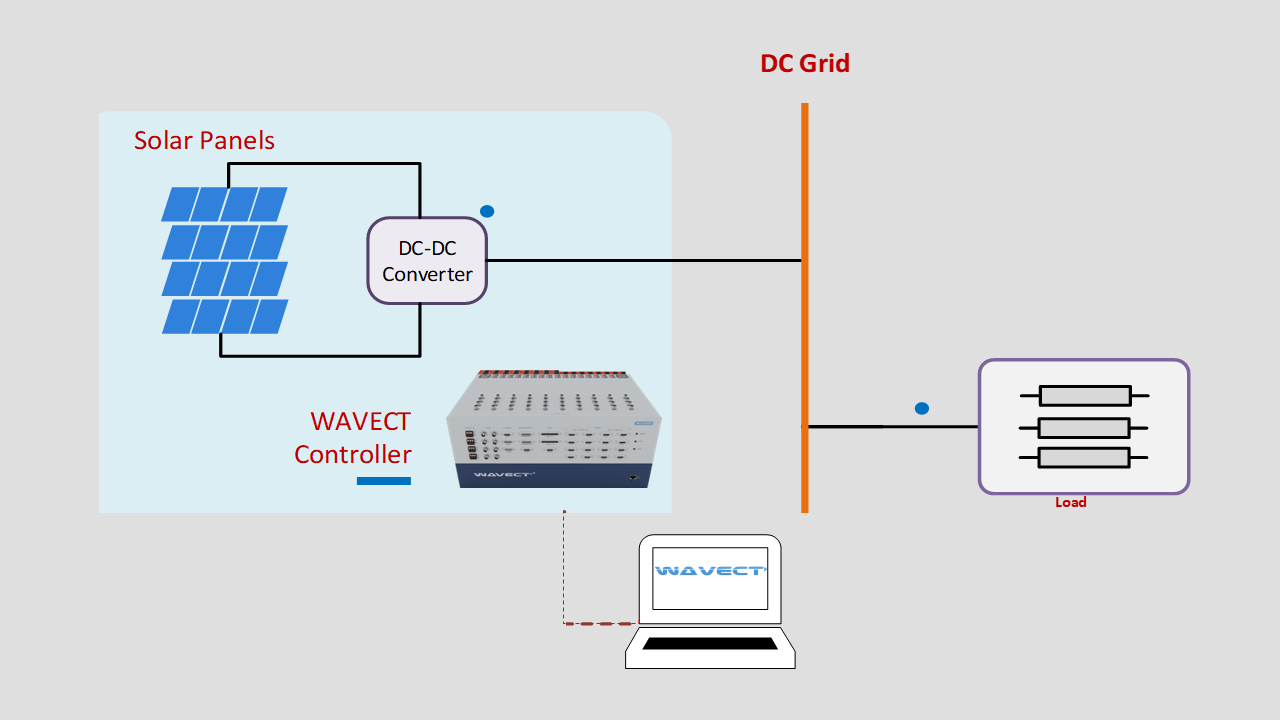
Stand Alone
These kind of systems are not connected to utility grid, they are self contained and are generally used in remote or rural areas
Send EnquiryIntroduction :
The global energy consumption is rising and an increasing attention is being paid to alternative methods of electricity generation. The very low environmental impact of the renewable energies makes them a very attractive solution for a growing demand. In this trend towards the diversification of the energy market, solar energy is a promising sustainable energy source.
Solar PV systems are generally classified into Stand alone, Grid-Connected and Hybrid Systems.
Stand-Alone PV Systems :
These kind of systems are not connected to utility grid, they are self contained and are generally used in remote or rural areas
Specifications
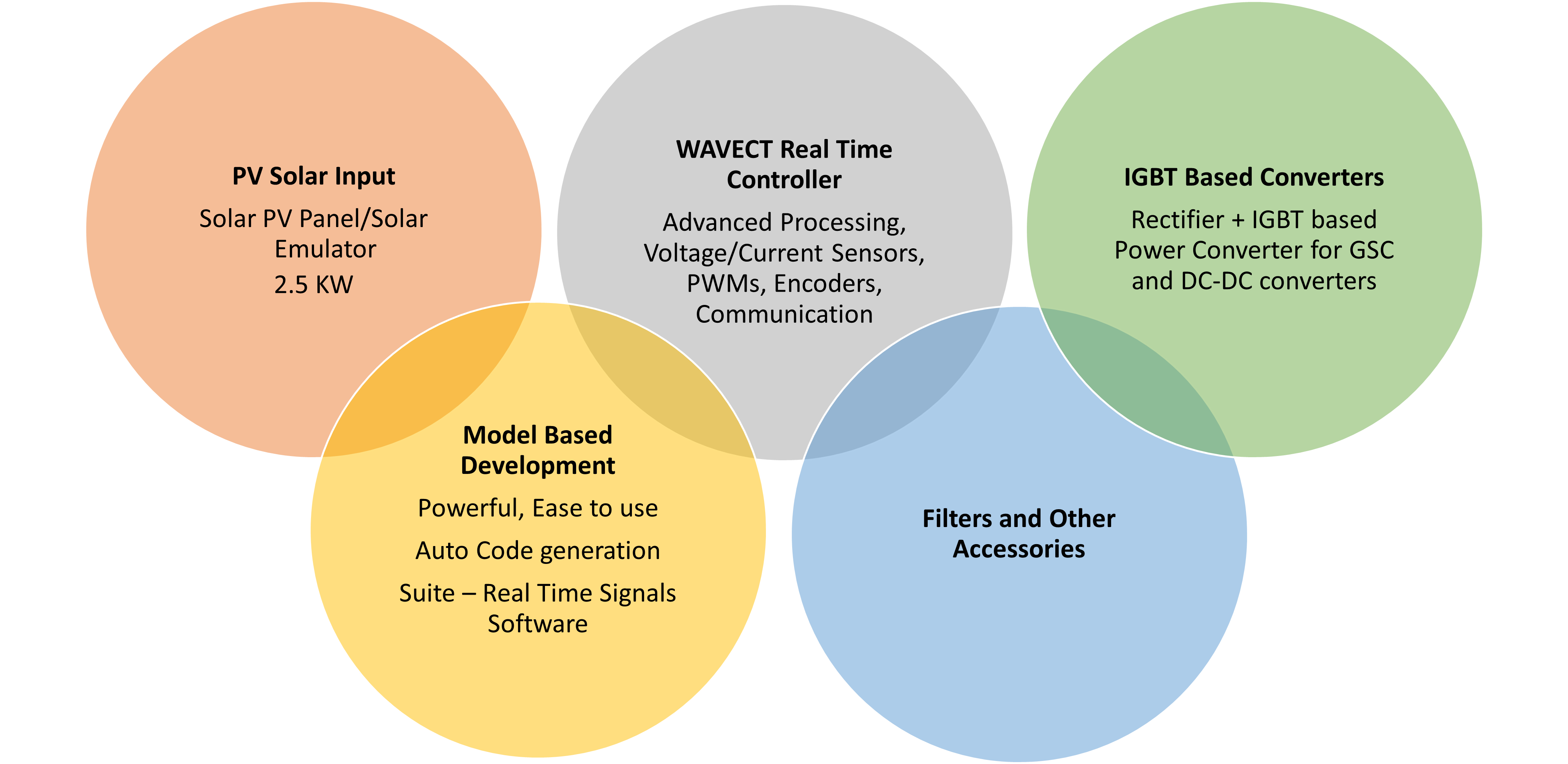
Key Functionalities
Stand-Alone PV Systems setup is fully user programmable. To quick start the user control design process, system is delivered with a full fleshed reference design. This reference design shows the complete operation of the setup. Its control design key functions are as follows.
- PAO MPPT algorithm for the maximum extraction of power.
- Independent Active Power(P) & Reactive Power (Q) control for Grid Side Converter(GSC)
- during poor weather and the converters used to meet reactive power demand of the grid.
- Auto-isolation of Solar panel and converters from the power under different faulty conditions.
- Provision for developing user defined control algorithms in Matlab-System Generator/HDL Coder environment.
Grid Connected PV System
These type of systems are directly connected to grid via DC-AC Inverter. They are less expensive and no storage is required. In case of excess solar energy, power can be fed to grid directly and during poor weather power is supplied from AC mains and the converters can used to meet reactive power demand of the grid.
Send Enquiry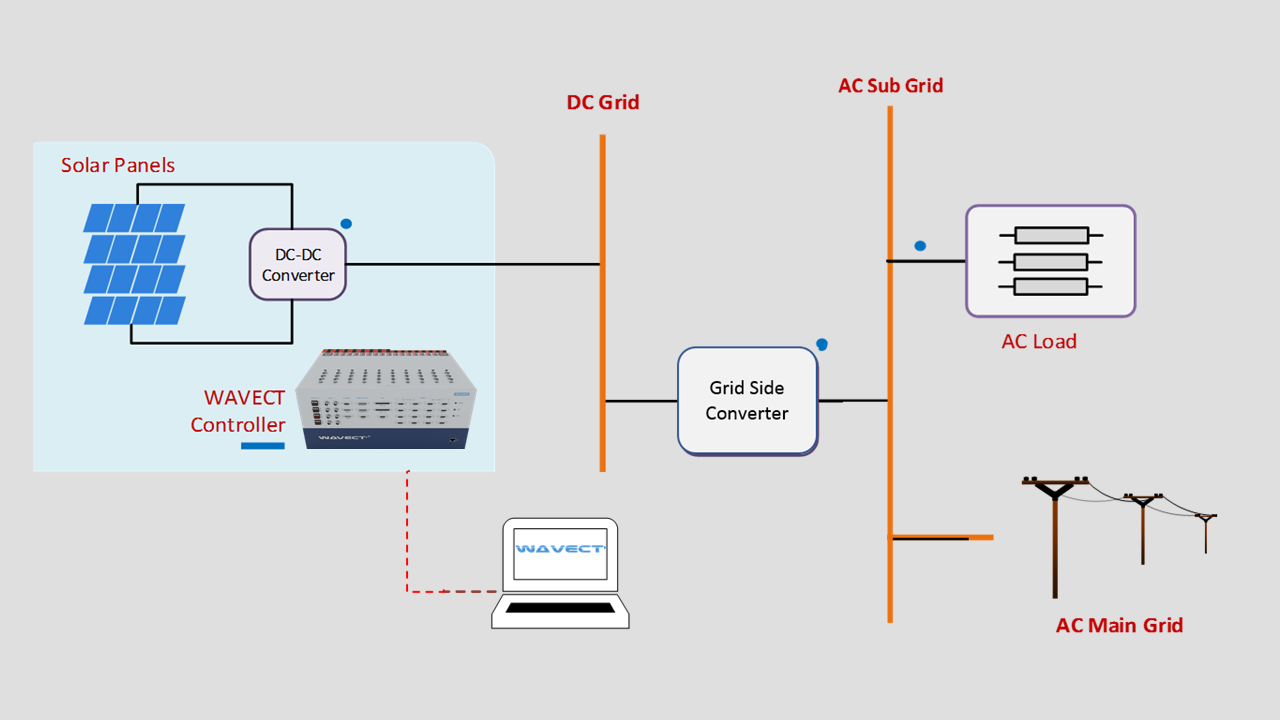
Introduction :
The global energy consumption is rising and an increasing attention is being paid to alternative methods of electricity generation. The very low environmental impact of the renewable energies makes them a very attractive solution for a growing demand. In this trend towards the diversification of the energy market, solar energy is a promising sustainable energy source.
Solar PV systems are generally classified into Standalone, Grid-Connected and Hybrid Systems.
Grid Connected PV System :
These type of systems are directly connected to grid via DC-AC Inverter. They are less expensive and no storage is required. In case of excess solar energy, power can be fed to grid directly and during poor weather power is supplied from AC mains and the converters can used to meet reactive power demand of the grid.
The potential list of Experiments & Research scope as :
- Possible fault occurrences.
- IEffect of possible faults at the system.
- Study of MPPT system.
- Run and test MPPT algorithm.
- Compare the Results with and without MPPT
- Different MPPT algorithm development.
- Inverter control testing for different operating conditions
- Performance Analysis of Photovoltaic Panel.
- Testing of charge Controller.
Specifications
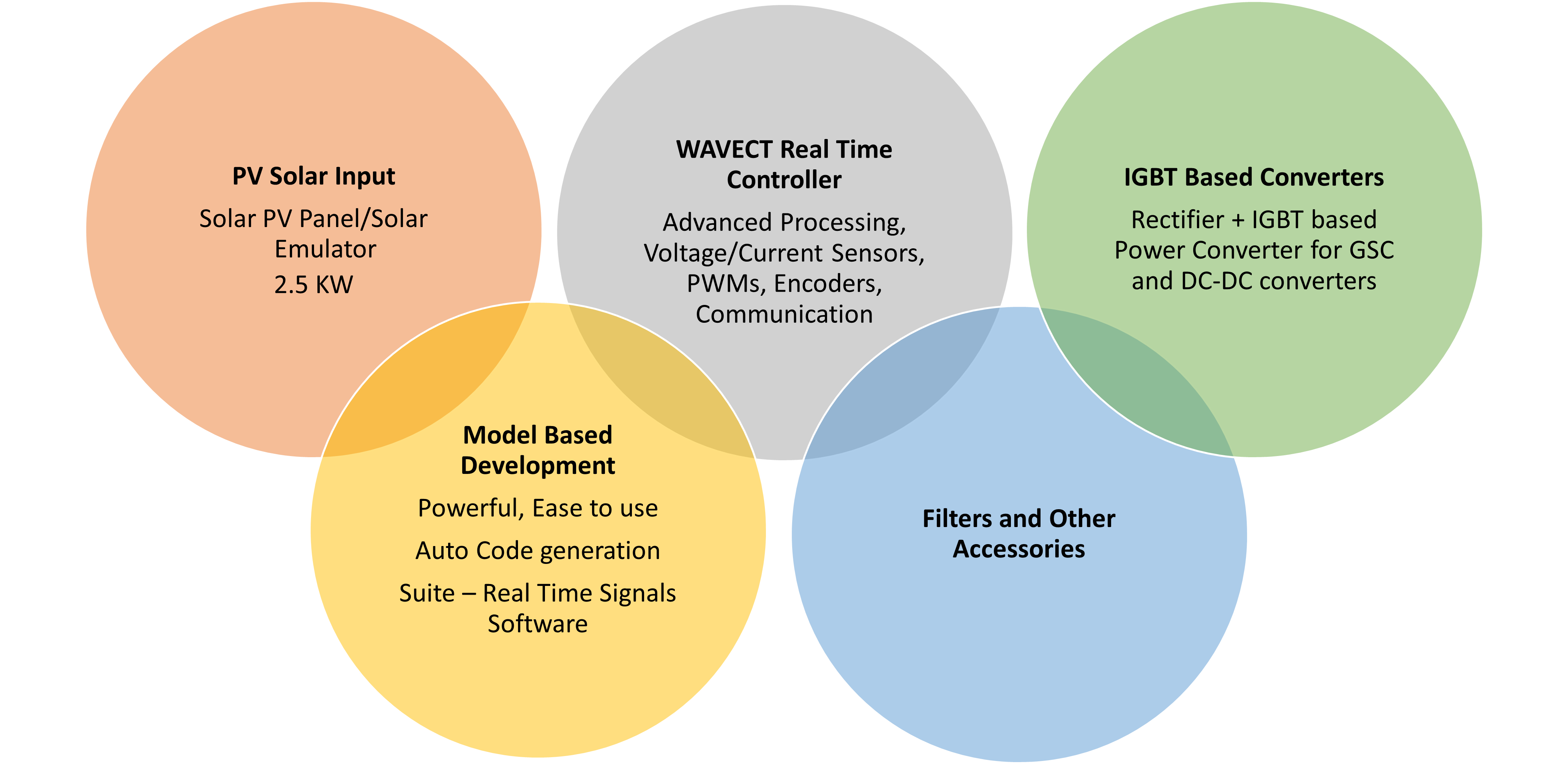
Key Functionalities
Grid connected solar PV setup is fully user programmable. To quick start the user control design process, system is delivered with a full fleshed reference design. This reference design shows the complete operation of the setup. Its control design key functions are as follows.
- PAO MPPT algorithm for the maximum extraction of power.
- Independent Active Power(P) & Reactive Power (Q) control for Grid Side Converter(GSC)
- during poor weather and the converters used to meet reactive power demand of the grid.
- Auto-isolation of Solar panel and converters from the power under different faulty conditions.
- Provision for developing user defined control algorithms in Matlab-System Generator/HDL Coder environment.
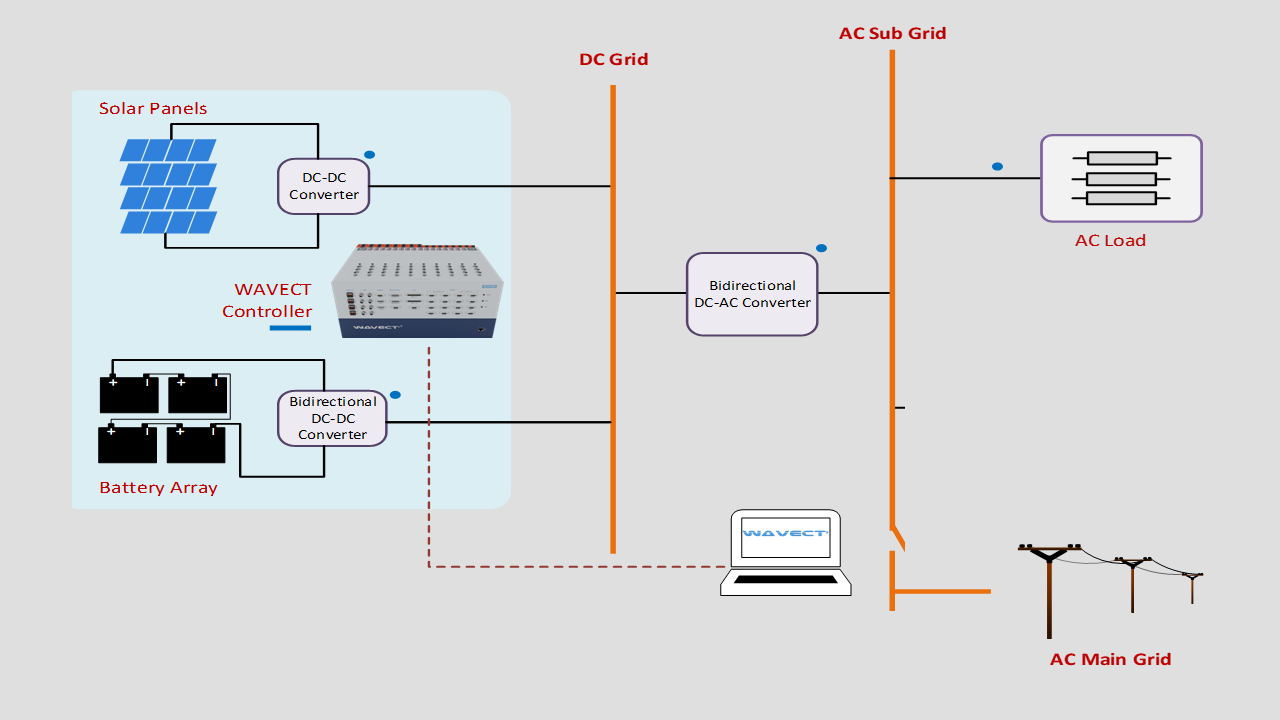
Hybrid PV System
Hybrid system is the combination of above two systems, it can work as a grid connected system or as a standalone system with the help of batteries.
Send EnquiryIntroduction :
The global energy consumption is rising and an increasing attention is being paid to alternative methods of electricity generation. The very low environmental impact of the renewable energies makes them a very attractive solution for a growing demand. In this trend towards the diversification of the energy market, solar energy is a promising sustainable energy source.
Solar PV systems are generally classified into Stand alone, Grid-Connected and Hybrid Systems.
Hybrid PV systems :
Hybrid system is the combination of above two systems, it can work as a grid connected system or as a standalone system with the help of batteries.
System Potential Scope :
The Proposed Configuration is quite open scalable and modular , therefore there are multi-dimensional provisions to deploy the entire configuration or the individual components.
The potential list of Experiments & Research scope as :
- Possible fault occurrences.
- IEffect of possible faults at the system.
- Study of MPPT system.
- Run and test MPPT algorithm.
- Compare the Results with and without MPPT
- Different MPPT algorithm development.
- Inverter control testing for different operating conditions
- Performance Analysis of Photovoltaic Panel.
- Testing of charge Controller.
Specifications (Hybrid PV Systems)
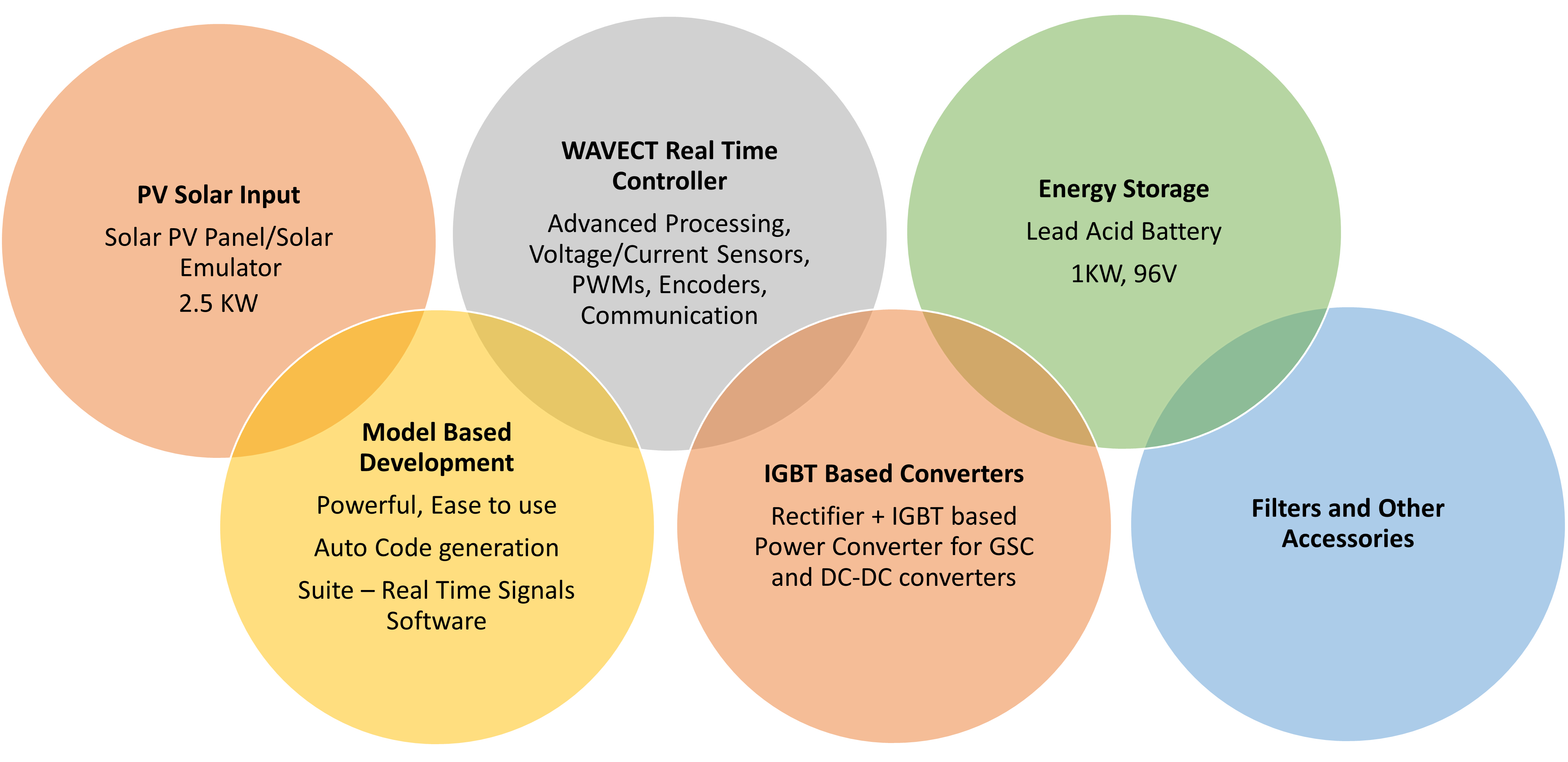
Key Functionalities
Hybrid PV System setup is fully user programmable. To quick start the user control design process, system is delivered with a full fleshed reference design. This reference design shows the complete operation of the setup. Its control design key functions are as follows.
- PAO MPPT algorithm for the maximum extraction of power.
- Independent Active Power(P) & Reactive Power (Q) control for Grid Side Converter(GSC)
- during poor weather and the converters used to meet reactive power demand of the grid.
- Auto-isolation of Solar panel and converters from the power under different faulty conditions.
- Provision for developing user defined control algorithms in Matlab-System Generator/HDL Coder environment.